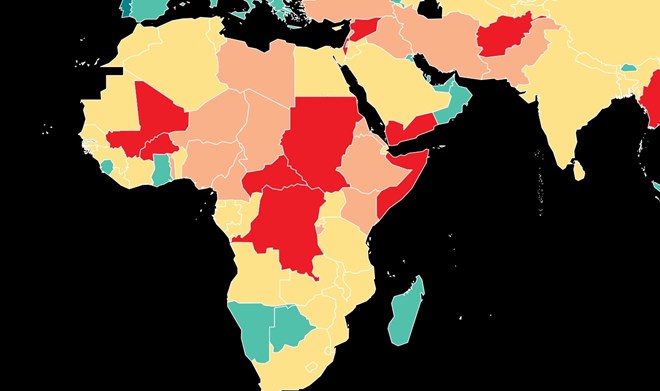
Thursday September 4, 2025

Mogadishu (HOL) — Somalia’s standing on the Global Peace Index has inched upward over the past decade
after a low point early in the 2010s, and the latest report shows another small improvement in 2025.
Somalia
improved slightly in the 2025 Global Peace Index, climbing to 151st out of 163 countries with a score of 2.983, but it remains just outside the bottom ten worldwide as conflict, terrorism and weak security institutions continue to strain society and the economy.
The Sydney-based Institute for Economics & Peace (IEP), which compiles the annual index, gave Somalia an overall score of 2.983, a modest gain from last year’s 3.023. It is the first time in nearly two decades the country’s score has fallen below 3.0, reflecting fewer conflict deaths and a slight easing of political instability since government forces and allied militias launched offensives against al-Shabaab in 2022.
Somalia has been tracked by the Global Peace Index since 2008, when it ranked near the bottom. Conditions worsened through the late 2000s, and by 2012 Somalia was 162nd, its lowest position, during the height of the insurgency. Since then, the overall score has generally eased from 3.34 in 2010 toward today’s 2.983, reflecting a slow shift from all-out urban fighting to a protracted insurgency and intermittent political stabilisation.
Despite the modest improvement, Somalia remains barely out of the bottom ten in the Global Peace Index, ranking just ahead of Burkina Faso, Mali, and South Sudan, but worse than Nigeria and the Central African Republic. Globally, only countries such as Yemen, Afghanistan, Sudan, and the Democratic Republic of the Congo scored lower.
The index measures peace across three areas: societal safety and security, ongoing conflict, and militarisation. Somalia scored poorly on the first two, recording 3.134 for safety and security and 3.542 for ongoing conflict, which reflect persistent violence, terrorism and displacement. Its 1.811 score on militarisation appears more favourable, but the figure reflects limited military capacity and low defense spending rather than genuine stability.
The IEP noted that Somalia’s safety score barely shifted, underscoring persistent terrorist attacks, mass displacement and weak policing. Conflict indicators improved modestly, with fatalities dropping more than 70 percent in 2023 compared to the year before, though al-Shabaab remains capable of large-scale assaults.
The GPI also calculates the cost of violence. For Somalia, the figure is staggering: 24.71 percent of GDP in 2024, one of the six worst ratios globally. Afghanistan and Ukraine topped the list, each losing over 40 percent of GDP to violence, while the global average among the ten most affected countries was 27.8 percent.
For Somalia, the economic impact is visible in inflated food prices, high transport costs and an overburdened national budget.
The World Bank’s 2020 Somalia Economic Update notes that the security sector accounted for approximately one-third (about US $107 million) of the federal government’s expenditure in 2019, and made up 48% of the wage bill, leaving little for health or education. Economists warn that without sustained peace, Somalia risks trapping its youth in cycles of unemployment and radicalisation.
Worldwide, the GPI found the economic cost of violence reached $19.97 trillion in 2024, equal to 11.6 percent of global GDP, or $2,455 per person. Since 2008, conflict-related costs such as deaths, GDP losses and refugee displacement have more than tripled.
The report highlights stark differences in the Horn of Africa. Somalia’s score of 2.983 compares unfavourably with Kenya (2.392, ranked 127th) and Djibouti (2.276, ranked 122nd), but is slightly better than South Sudan (3.117, ranked 156th) and Mali (3.061, ranked 154th). The Sub-Saharan Africa regional average is 2.299, illustrating Somalia’s gap with its neighbours.
The region as a whole recorded a 0.17 percent deterioration in peacefulness last year, with political unrest and terrorism in the Central Sahel driving much of the decline. Three of the world’s ten least peaceful countries are in Sub-Saharan Africa.



